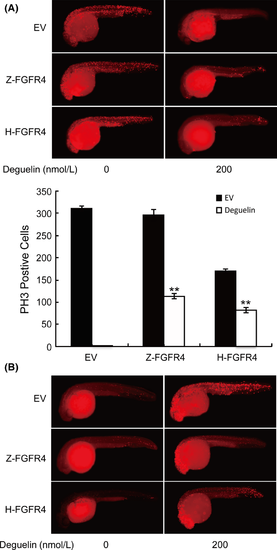- Title
-
Deguelin-induced blockade of PI3K/protein kinase B/MAP kinase signaling in zebrafish and breast cancer cell lines is mediated by down-regulation of fibroblast growth factor receptor 4 activity
- Authors
- Wu, W., Hai, Y., Chen, L., Liu, R.J., Han, Y.X., Li, W.H., Li, S., Lin, S., Wu, X.R.
- Source
- Full text @ Pharmacol Res Perspect
|
Growth repression and apoptosis induction caused by deguelin. (A) Morphological change in zebrafish with or without deguelin treatment. Significant growth retardation can be found in 200 and 500 nmol/L deguelin-treated group. (B) Whole-mount embryos labeled with anti-pH3 antibody to examine proliferating cells in zebrafish larvae. The numbers of pH3-positive cells decreased dramatically and rarely expressed with 200 nmol/L deguelin treatment (magnification 50×). (C) Phenotypic assessed by terminal deoxynucleotidyl transferase dUTP nick end labeling (TUNEL) staining. There was a dose-dependent increase of apoptotic cells in TUNEL assay. (magnification 50×). |
|
The counteractant effect of overexpressing FGFR4 in zebrafish after deguelin treatment. (A) Zebrafish embryos were labeled with anti-pH3 antibody after injection of pEGFP-C3 containing FGFR4 (Z-FGFR4 and H-FGFR4 stand for zebrafish and human FGFR4, respectively) to detect proliferating cells. DyLight 594 secondary antibody was used to avoid green fluorescence emitted by pEGFP-C3 vector. Up-regulation of FGFR4 has partly restored proliferating cells compared with the control group. PH3-positive cells are counted in Image J. **P < 0.01 (t-test) (B). TUNEL assay was conducted to analyze the apoptosis after the injection of FGFR4. Apoptotic cells were reduced in the trunk areas in injected groups. FGFR4, fibroblast growth factor receptor 4; TUNEL, terminal deoxynucleotidyl transferase dUTP nick end labeling. |


